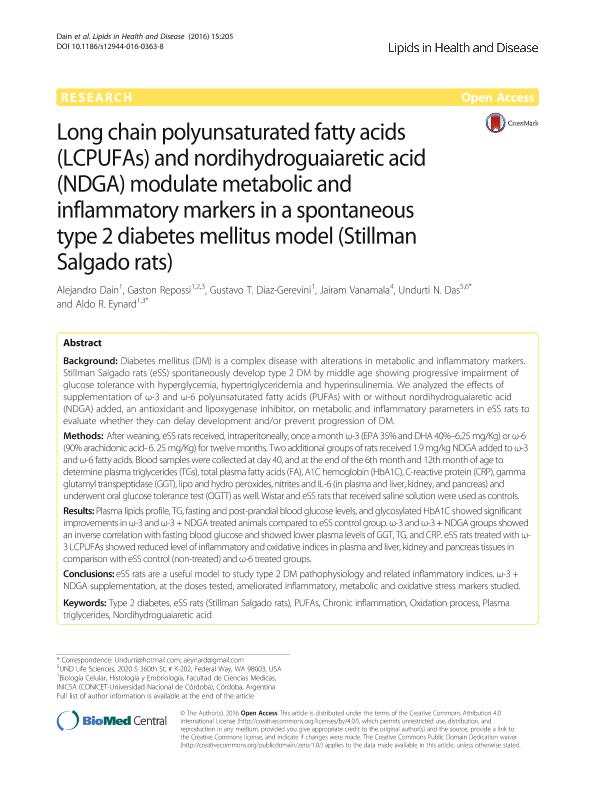Artículo
Long chain polyunsaturated fatty acids (LCPUFAs) and nordihydroguaiaretic acid (NDGA) modulate metabolic and inflammatory markers in a spontaneous type 2 diabetes mellitus model (Stillman Salgado rats)
Dain, Alejandro; Repossi Marquez, Pablo Gaston ; Diaz Gerevini, Gustavo T.; Vanamala, Jairam; Das, Undurti N.; Eynard, Aldo Renato
; Diaz Gerevini, Gustavo T.; Vanamala, Jairam; Das, Undurti N.; Eynard, Aldo Renato
 ; Diaz Gerevini, Gustavo T.; Vanamala, Jairam; Das, Undurti N.; Eynard, Aldo Renato
; Diaz Gerevini, Gustavo T.; Vanamala, Jairam; Das, Undurti N.; Eynard, Aldo Renato
Fecha de publicación:
12/2016
Editorial:
BioMed Central
Revista:
Lipids In Health And Disease
ISSN:
1476-511X
Idioma:
Inglés
Tipo de recurso:
Artículo publicado
Clasificación temática:
Resumen
Diabetes mellitus (DM) is a complex disease with alterations in metabolic and inflammatory markers. Stillman Salgado rats (eSS) spontaneously develop type 2 DM by middle age showing progressive impairment of glucose tolerance with hyperglycemia, hypertriglyceridemia and hyperinsulinemia. We analyzed the effects of supplementation of ω-3 and ω-6 polyunsaturated fatty acids (PUFAs) with or without nordihydroguaiaretic acid (NDGA) added, an antioxidant and lipoxygenase inhibitor, on metabolic and inflammatory parameters in eSS rats to evaluate whether they can delay development and/or prevent progression of DM. Methods: After weaning, eSS rats received, intraperitoneally, once a month ω-3 (EPA 35% and DHA 40%-6.25 mg/Kg) or ω-6 (90% arachidonic acid- 6. 25 mg/Kg) for twelve months. Two additional groups of rats received 1.9 mg/kg NDGA added to ω-3 and ω-6 fatty acids. Blood samples were collected at day 40, and at the end of the 6th month and 12th month of age to determine plasma triglycerides (TGs), total plasma fatty acids (FA), A1C hemoglobin (HbA1C), C-reactive protein (CRP), gamma glutamyl transpeptidase (GGT), lipo and hydro peroxides, nitrites and IL-6 (in plasma and liver, kidney, and pancreas) and underwent oral glucose tolerance test (OGTT) as well. Wistar and eSS rats that received saline solution were used as controls. Results: Plasma lipids profile, TG, fasting and post-prandial blood glucose levels, and glycosylated HbA1C showed significant improvements in ω-3 and ω-3 + NDGA treated animals compared to eSS control group. ω-3 and ω-3 + NDGA groups showed an inverse correlation with fasting blood glucose and showed lower plasma levels of GGT, TG, and CRP. eSS rats treated with ω-3 LCPUFAs showed reduced level of inflammatory and oxidative indices in plasma and liver, kidney and pancreas tissues in comparison with eSS control (non-treated) and ω-6 treated groups. Conclusions: eSS rats are a useful model to study type 2 DM pathophysiology and related inflammatory indices. ω-3 + NDGA supplementation, at the doses tested, ameliorated inflammatory, metabolic and oxidative stress markers studied.
Archivos asociados
Licencia
Identificadores
Colecciones
Articulos(INICSA)
Articulos de INSTITUTO DE INVESTIGACIONES EN CIENCIAS DE LA SALUD
Articulos de INSTITUTO DE INVESTIGACIONES EN CIENCIAS DE LA SALUD
Citación
Dain, Alejandro; Repossi Marquez, Pablo Gaston; Diaz Gerevini, Gustavo T.; Vanamala, Jairam; Das, Undurti N.; et al.; Long chain polyunsaturated fatty acids (LCPUFAs) and nordihydroguaiaretic acid (NDGA) modulate metabolic and inflammatory markers in a spontaneous type 2 diabetes mellitus model (Stillman Salgado rats); BioMed Central; Lipids In Health And Disease; 15; 205; 12-2016; 1-15
Compartir
Altmétricas



